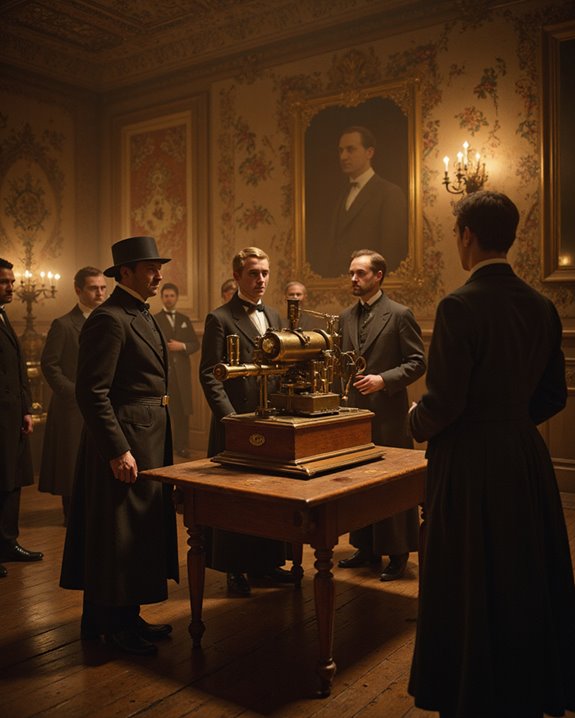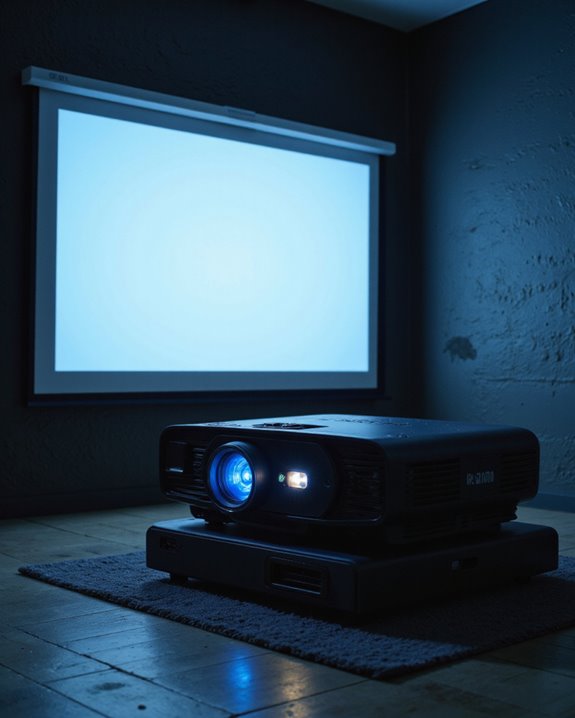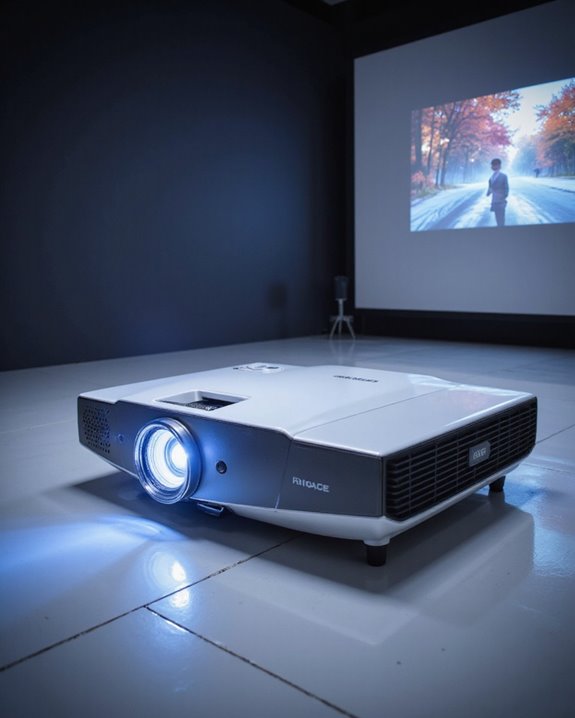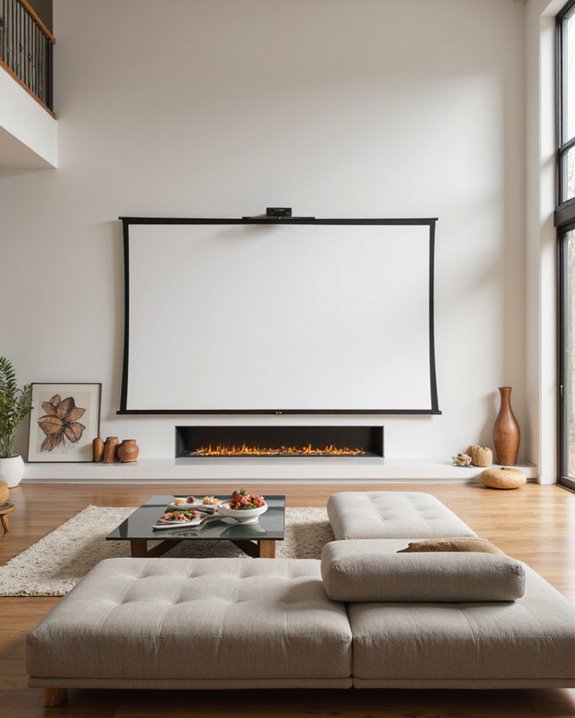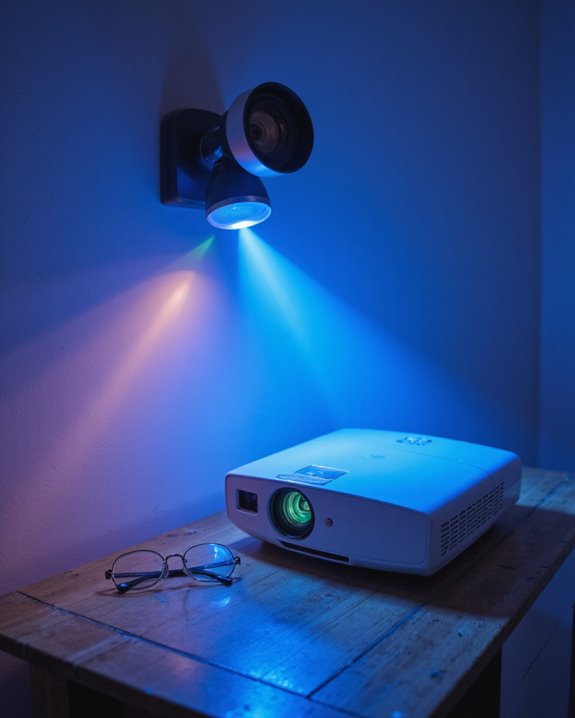Yes, projectors existed in 1899, most especially devices like magic lanterns and the Cinématographe. Magic lanterns used painted glass slides and light sources (candles, limelight) to project images, while early film projectors displayed silent movies using mechanical systems and 35mm film. These early devices had no digital features, relied on perforated film for smoother movement, and were built for group viewing in theaters. Innovations from this era shaped later projection technology; further details show their wider impact and evolution.
Key Takeaways
- Projectors did exist in 1899, primarily using mechanical and optical systems for displaying silent films and magic lantern slides.
- Early projectors used light sources like limelight or carbon arc lamps and lacked digital or electronic features.
- The Lumière brothers’ Cinématographe (1895) and similar devices enabled public screenings of moving images before 1900.
- These projectors played a major role in the rise of early movie theaters and group entertainment.
- While foundational, 1899 projectors were limited in image quality and functionality compared to modern digital systems.
The Origins of Projection Devices
The origins of projection devices trace back to a period of rapid scientific and technological advancement in the late 19th century. Early projectors made it possible to display silent films—movies without recorded sound—by using innovative projection mechanics. These mechanics included the use of light sources, lenses, mirrors, and moving film strips to cast images onto screens. Key developments included:
- Eadweard Muybridge’s Zoopraxiscope (1879), which displayed moving images using glass slides.
- Louis Le Prince’s 16-lens device (1886), combining camera and projector functions.
- The Lumière Brothers’ Cinématographe (1895), integrating camera, projector, and film processing.
Advancements in optics and illumination, such as electric lamps, improved image quality and projection distance. By 1899, projectors were capable of showing motion pictures in public venues.
Magic Lanterns and Pre-Film Innovations
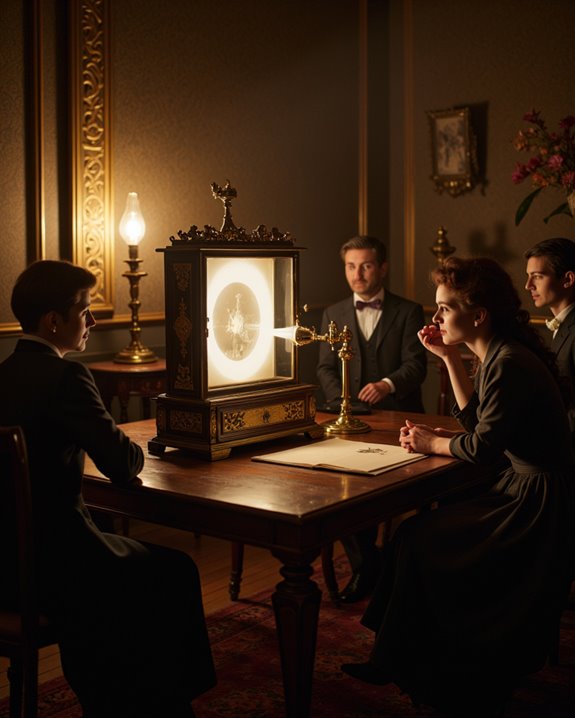
Before the rise of motion picture projectors at the end of the 19th century, magic lanterns stood as the primary technology for image projection. A magic lantern is an optical projector that uses painted or printed glass slides and a light source to display images on a wall or screen. Color enhancement was achieved by hand-tinting slides, adding visual appeal to educational lectures and entertainment shows. Light sources evolved from candles and single wick burners to kerosene lamps, limelight, and eventually carbon arc lights, delivering brighter, clearer images. Slide automation, involving mechanical devices to advance slides or create movement, introduced early animation effects. By 1899, manufacturers like Planck were producing up to 150,000 units yearly, demonstrating the global popularity and commercial success of magic lanterns. The use of high-brightness light sources and projection technology contributed significantly to the effectiveness of these devices in larger venues.
Key Figures in Early Projection Technology
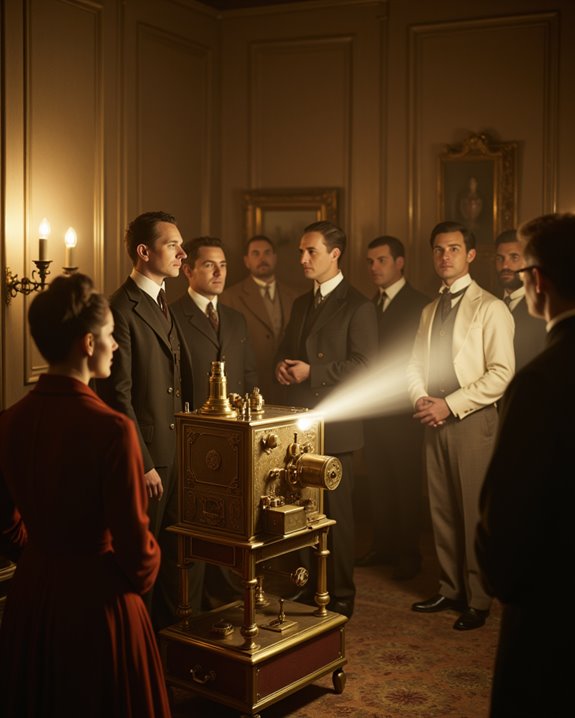
Several inventors and engineers played crucial roles in the early development of projection technology at the end of the 19th century. Charles Francis Jenkins, for example, created a machine that projected silent films by illuminating each frame for smoother viewing, making projector maintenance more manageable. The Lumière brothers introduced the Cinematographe, a device that combined camera, projector, and film development, making motion picture projection portable and efficient. Thomas Edison’s team, with William K.L. Dickson, shifted from individual Kinetoscope viewers to commercial large-screen projectors, further popularizing silent films. Joshua Lionel Cowen improved projection lighting with his flash-lamp, enhancing image brightness and clarity. Wilhelm Conrad Röntgen’s discovery of X-ray projection highlighted new imaging techniques, illustrating how projection technology was rapidly evolving in this era. The development of accurate projection systems with higher luminosity and precision set the stage for modern cinematic displays.
Breakthroughs in Film Materials and Mechanics
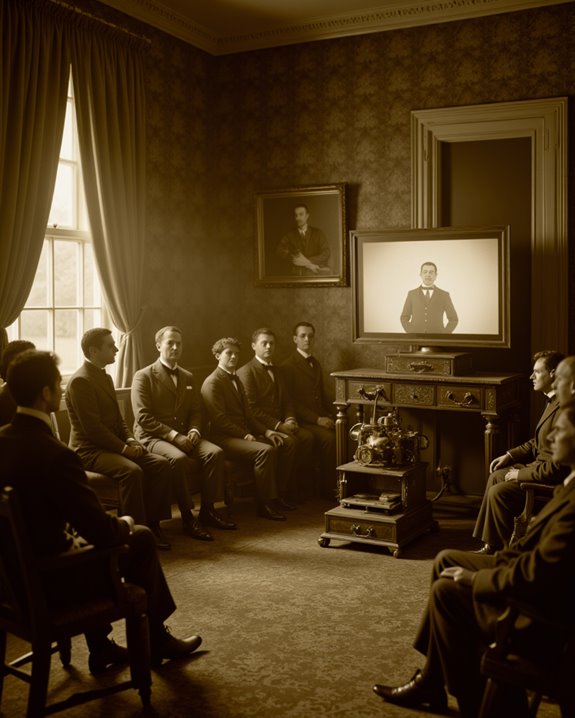
Although early projection technology relied on basic materials and simple mechanics, breakthroughs in film materials and device engineering during the late 1800s fundamentally changed motion picture projection. The introduction of perforated film—film with evenly spaced holes along the edges—enabled smoother, more reliable movement through projectors. Standardization of 35mm film stock, a flexible strip coated with light-sensitive chemicals, became widely adopted after use in Edison’s Kinetoscope. This format allowed for consistent projection speed, which is the rate at which film frames pass through a projector, enhancing the illusion of motion. Additional advances included the development of safer, less bulky film materials and narrower gauges like 9.5mm. Mechanical improvements—such as open-reel systems and effective shutter blades—reduced flicker and improved image clarity for viewers. These technical innovations laid the groundwork for the modern projection systems used today.
The Shift From Individual Viewing to Public Screenings

Breakthroughs in film materials and mechanics paved the way for a new era in how motion pictures were experienced. The late 1890s saw a significant cultural shift as cinema moved from individual viewing devices to shared public screenings. Devices like the Lumière brothers’ Cinématographe and Edison’s Vitascope were central to this transformation, projecting moving images onto makeshift screens for groups to watch together. Audience engagement increased as people gathered in closed rooms to view films, marking the beginning of communal cinema experiences. This change democratized entertainment, making films accessible beyond private parlors. The rise of early theaters, storefront venues, and eventually Nickelodeons (five-cent theaters) fostered a new social space. Public screenings quickly became a cultural phenomenon, influencing popular culture and accelerating the growth of the film industry.
Landmark Projection Systems of the 1890s
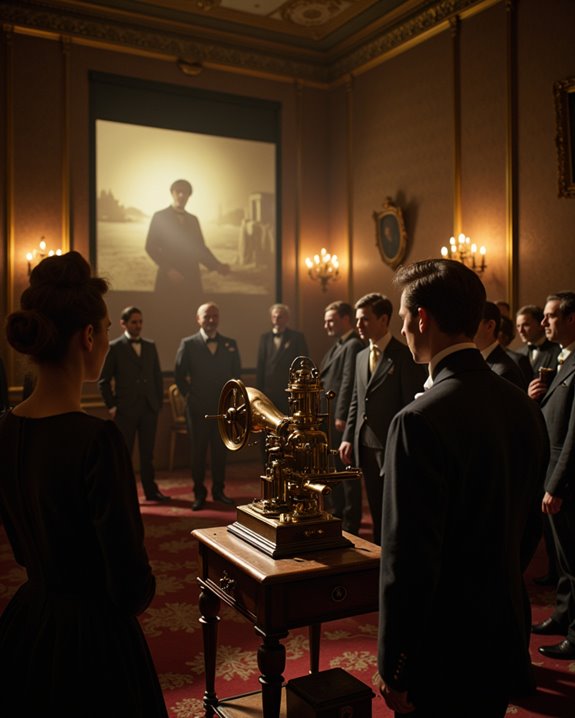
How did motion pictures shift from private curiosities to public spectacles in the 1890s? Key inventions such as the Cinematograph, Eidoloscope, and Vitascope enabled the projection of silent films onto screens, transforming the viewing experience. The Kinetoscope, though not a projector, introduced perforated film, which allowed smoother film movement and set the stage for future systems. Landmark devices included:
- Cinematograph (Leon Bouly, 1892): Early projector for public screenings.
- Eidoloscope (Woodville Latham): Demonstrated in 1895, advanced projection quality.
- Biograph: Used larger, non-perforated film for sharper images.
Innovations like intermittent movement improved reliability and image clarity. These projection systems replaced individual peephole viewers, enabling widespread public acceptance and global expansion of silent films, and greatly enhanced projection quality for audiences across regions.
Social and Economic Effects of Early Projectors
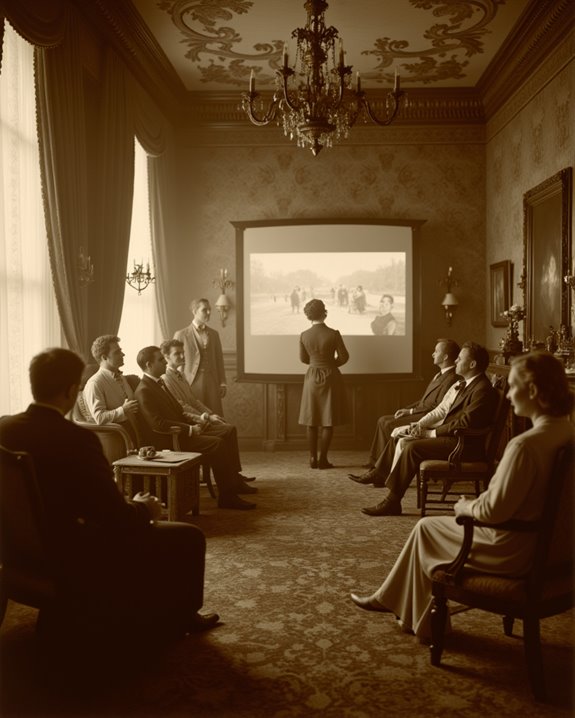
As early projectors appeared in the 1890s, they quickly reshaped both social life and economic activity by making motion pictures a shared, public experience. This technological innovation fueled the rise of cinema, transforming entertainment into a collective event. Theaters and other venues adapted to accommodate projectors, creating new business opportunities and job roles. Early projectors also drove market expansion, with films distributed to wider audiences. Their introduction fostered competition and further technological innovation among inventors.
The cultural influence of projectors was significant:
- They enabled cultural exchange by displaying films from different regions.
- Public gatherings around projected images increased social interaction.
- Projectors supported educational uses, spreading information visually.
This combination of novelty, economic growth, and cultural influence solidified early projection’s impact across society.
Evolution Toward Modern Projection Technology

While projection technology began with simple devices like the magic lantern, it has evolved into highly advanced systems that define modern visual experiences. Today, projectors feature digital connectivity, which means they can link to computers, smartphones, or networks for easy image sharing. Portable design is also a key development, as modern projectors are lightweight and easy to move. Advances include:
- Laser projectors, offering high brightness and long lifespan
- LED projectors, known for energy efficiency
- High-definition displays, supporting sharp, detailed visuals
- Smart projectors, with app integration and wireless options
The shift to digital projection panels in the 1980s allowed for direct connection to computers. These changes make projection accessible in classrooms, offices, and homes, transforming how audiences experience media and information.
Frequently Asked Questions
How Much Did Early Projectors Cost in the 1890S?
Historical costs of early projection technology in the 1890s are difficult to pinpoint, but projectors were considered expensive investments. Pricing likely limited ownership to commercial exhibitors, as projection technology targeted businesses rather than individual consumers during this formative period.
Were Projectors Used for Educational Purposes in 1899?
While silent films flickered in theaters, classrooms remained largely untouched by educational technology in 1899. Projectors, though recognized for their potential, were rare in schools, with magic lanterns occasionally used as visual aids but not widely adopted.
What Was the Typical Length of Films Shown on Early Projectors?
Typical film reel lengths displayed by early projection technology ranged from 15 seconds to one minute. These short durations reflected technological limitations of the era and the infancy of narrative filmmaking, with longer films emerging only in the early 1900s.
How Did Audiences React to Their First Projected Films?
Audiences at silent screenings experienced unprecedented excitement, often reacting with astonishment or even fear to the lifelike motion. Collective surprise, vocal responses, and applause marked these early encounters, as viewers navigated the novel sensory impact of projected moving images.
Were Color Films Possible With Projection Devices in 1899?
Color projection in 1899 was technically possible but faced significant technical limitations. Specialized equipment and complex filter alignment were required, making early color film processes impractical and commercially unviable. These attempts, however, influenced future advancements in color cinema technology.

